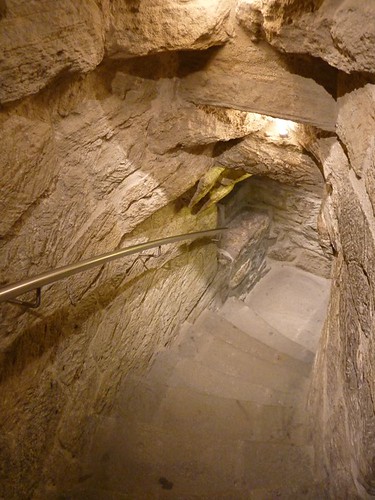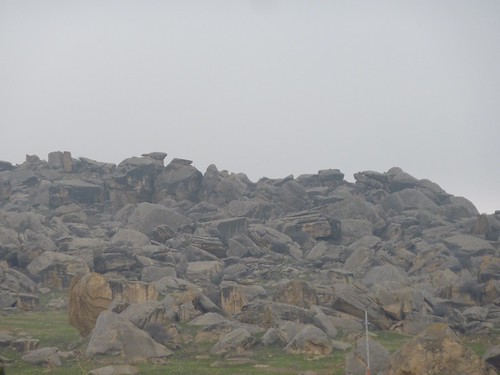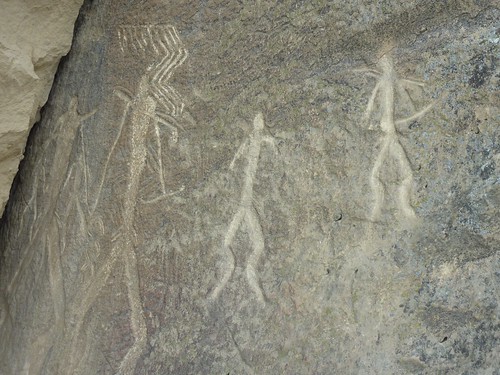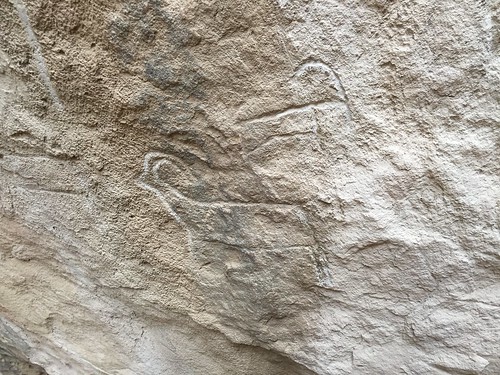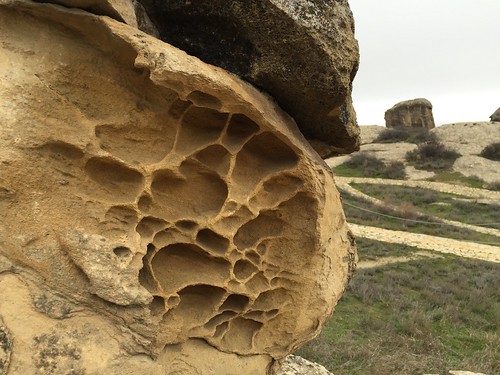Remember Gobustan? Well it turned out that wasn’t the only bloggy thing I did that weekend. On the following Sunday, after carefully considering my To Do List, I quietly chucked it all and decided it was high time that I visited Baku’s most famous landmark, the Maiden Tower.
The Maiden Tower is possibly the most ubiquitous symbol of Baku, appearing on keychains, coins and bank notes, tea sets, commemorative plates, carpets, t-shirts, and just about anything else. It’s not the tallest tower ever - a mere 97 feet - but considering it was built in about the 11th or 12th century it’s pretty impressive. It’s also got a very interesting, massive buttress sticking out one side that some people say makes it look like a buta symbol when viewed from above. (Note “buta” is pronounced BOO-tuh.) The buta - a shape we in English call paisley - is very important in Azerbaijan culture. It’s often said that the buta represents fire, and considering that Azerbaijan means “land of fire”, you can see why it might be important. Butas appear as decoration on things a lot. Perhaps even more than the Maiden Tower, which is saying something. There are even butas on the little antique copper bowl I bought to corral my keys ad loose change near the front door.
It is the law in Azerbaijan that when speaking of the Maiden Tower you are required to mention at least one of the various legends of why the tower is so named. The most boring theory is that the tower is “maiden” because it was never taken by force. Yawn. Much more interesting and dramatic is the tale of a king was trying to force his daughter to marry a man she didn’t love. As a stalling tactic, the daughter asked her father to build a tower so high that she could see all his lands from the top of it. When the tower was finally finished, the maiden climbed to the top and, rather than go through with the forced marriage, threw herself off to her death.
No one agrees on why the tower was built. Some assert it was for defense and fortification, and it even has a hidden water well reaching to an underground aquifer, which makes it seem possible that it was meant to withstand sieges (it’s estimated it would house about 200 people). However, the lack of convenient military appurtenances like arrow slits and murder holes and such makes that debatable. Others say it might have been an observatory, pointing out the the orientation of the big buttress and some of the windows line up with the position of the sun on some equinoxes (though I watched a little video on that in the museum inside the tower and I’m sceptical). Still others speculate it was built for religious observances. And given the fuzzy line between science and religion for much of human history, it’s possible the observatory theory and the religious observances theory are not mutually exclusive.
Like most structures of that era, the walls and foundations are massively heavy. Built into the sloping stone of the Caspian sea shore, there’s a theory that the big buttress is there to help stop the tower from toppling down the hill. Besides being weighty, the fact that the walls at the base of the tower are 16 feet thick (and only taper to about 12-14 feet at the top) mean that what’s big on the outside is not particularly roomy on the inside.
The outside of the tower shows an interesting striped effect where, above a certain point, the stone is laid with alternating rows projecting past the face of the wall. Inside, it’s been highly restored. Prior to the 1960s the tower had been quite neglected - all of its interior floor were missing (historians think they were made of wood, so it’s not surprise they didn’t last), and swifts were nesting in the cracks in the masonry. Archeological excavations took place in the 1960s, and in 2000 the site, and the neighbouring Shirvanshah's Palace (a blog for another day) were listed as UNESCO World Heritage Sites. It was threatened by a subsequent earthquake not long after and moved to the "List of World Heritage in Danger”, AKA the “This Place Will Be In Big Trouble If Somebody Doesn’t Do Something Pretty Smartly and We’re Really Not Kidding” List. Much more extensive renovations were done between 2009 and 2013 and the result is impressive.
The missing floors have been replaced with stone, creating domed ceilings on each of the tower’s 8 floors. (Though if the floors were originally wood, it begs the question why they would be restored in stone, which, in fact, is not a restoration at all so much as a renovation. I suppose we should simply be glad they didn't also elect to add a nice conservatory or loft conversion.) Each floor has a few quite nice exhibits, with the mandatory moody lighting and touchscreens and clever use of see-through video displays.
Most charmingly, those poor swifts whose nests were disturbed in the renovation work were provided with new condos just a short distance away. The whole side of a nearby building is covered with custom-design swift nesting boxes that are installed in particularly appropriate pattern.
And of course there’s the view, which, despite the rather modest height of the tower compared with the architecture of modern Baku, is still pretty impressive.
The Maiden Tower as seen in pre-dawn darkness, on a morning run.
My copper bowl - spot the butas! Working with copper is another very Azeri thing, so I was really pleased to pick this up for 20 manat. Though I suspect I disgraced myself and seven generations of my ancestors by NOT haggling in the slightest with the vendor when I bought it.
Another picture of the Maiden Tower. Because, you know, it's a blog about the Maiden Tower.
Like most structures of that era, the walls and foundations are massively heavy. Built into the sloping stone of the Caspian sea shore, there’s a theory that the big buttress is there to help stop the tower from toppling down the hill. Besides being weighty, the fact that the walls at the base of the tower are 16 feet thick (and only taper to about 12-14 feet at the top) mean that what’s big on the outside is not particularly roomy on the inside.
Here’s one of the few windows in the structure, with little steps leading up to it, illustrating the thickness of the walls. The stairs between floors are also built into space in the walls.
The missing floors have been replaced with stone, creating domed ceilings on each of the tower’s 8 floors. (Though if the floors were originally wood, it begs the question why they would be restored in stone, which, in fact, is not a restoration at all so much as a renovation. I suppose we should simply be glad they didn't also elect to add a nice conservatory or loft conversion.) Each floor has a few quite nice exhibits, with the mandatory moody lighting and touchscreens and clever use of see-through video displays.
Not a touchscreen video display. Rather, a shot of the stonework in one of the stairwells, with a very nice brushed steel handrail.
I’d wondered what those things were several times, and the answer is far cooler than I ever would have guessed.
Looking towards Baku city centre, with the Caspian on right
A wind-blown Pam, pictured with the Flame Towers, which are that trio of swoopy glass things on the right. Famous, those are, but also a subject for another day.
Because it's Baku, the top deck of the Maiden Tower is exceptionally windy, making it chilly to be up there for long. I took a mandatory selfie, then beat a retreat. You get three guesses as to where I went, and the first two don't count. That's right! It was a nice café where I could get a cappuccino and a pain au chocolat. Because there are rules about these things, and one of the rules is that diligent bloggable activity must be followed, wherever possible, with coffee and pastry. And we here at Go Stay Work Play Live are sticklers for the rules.





